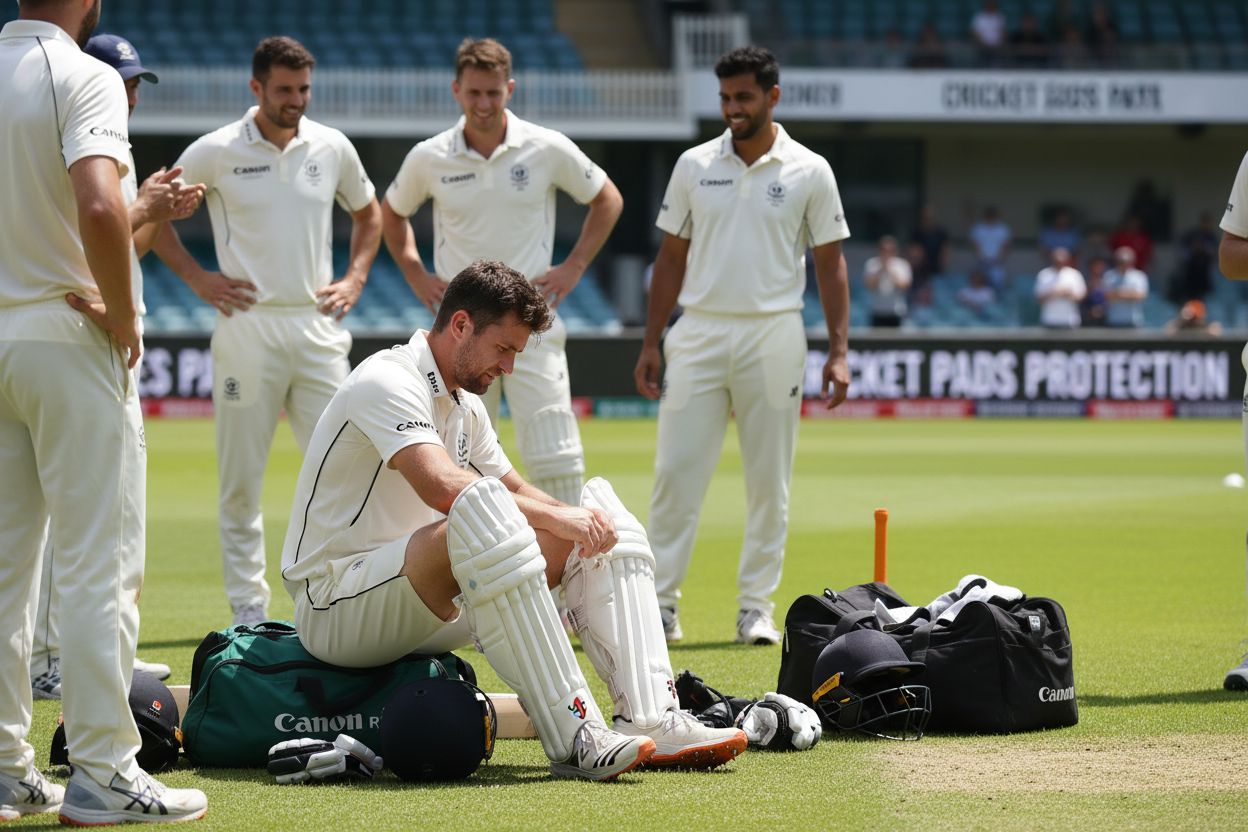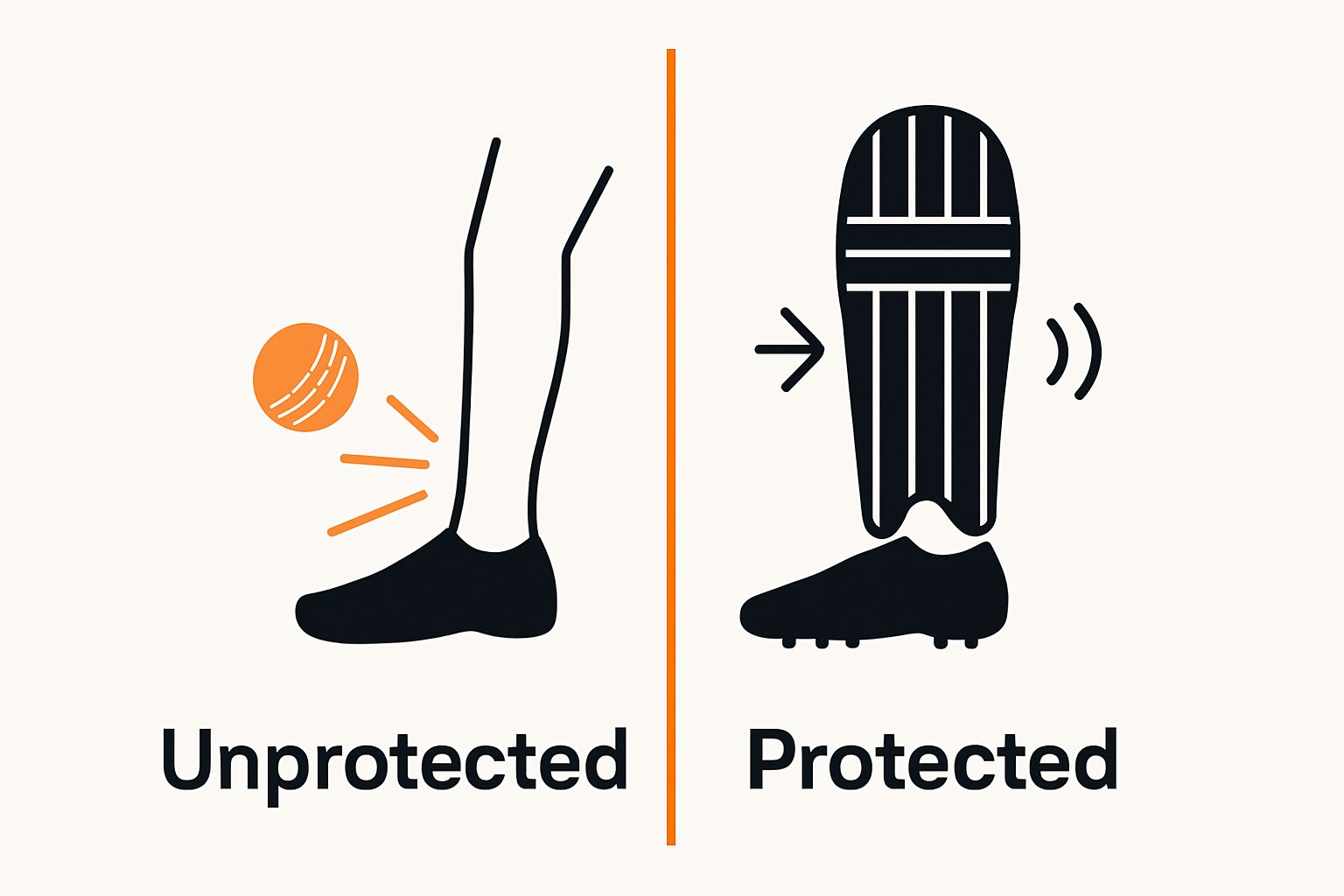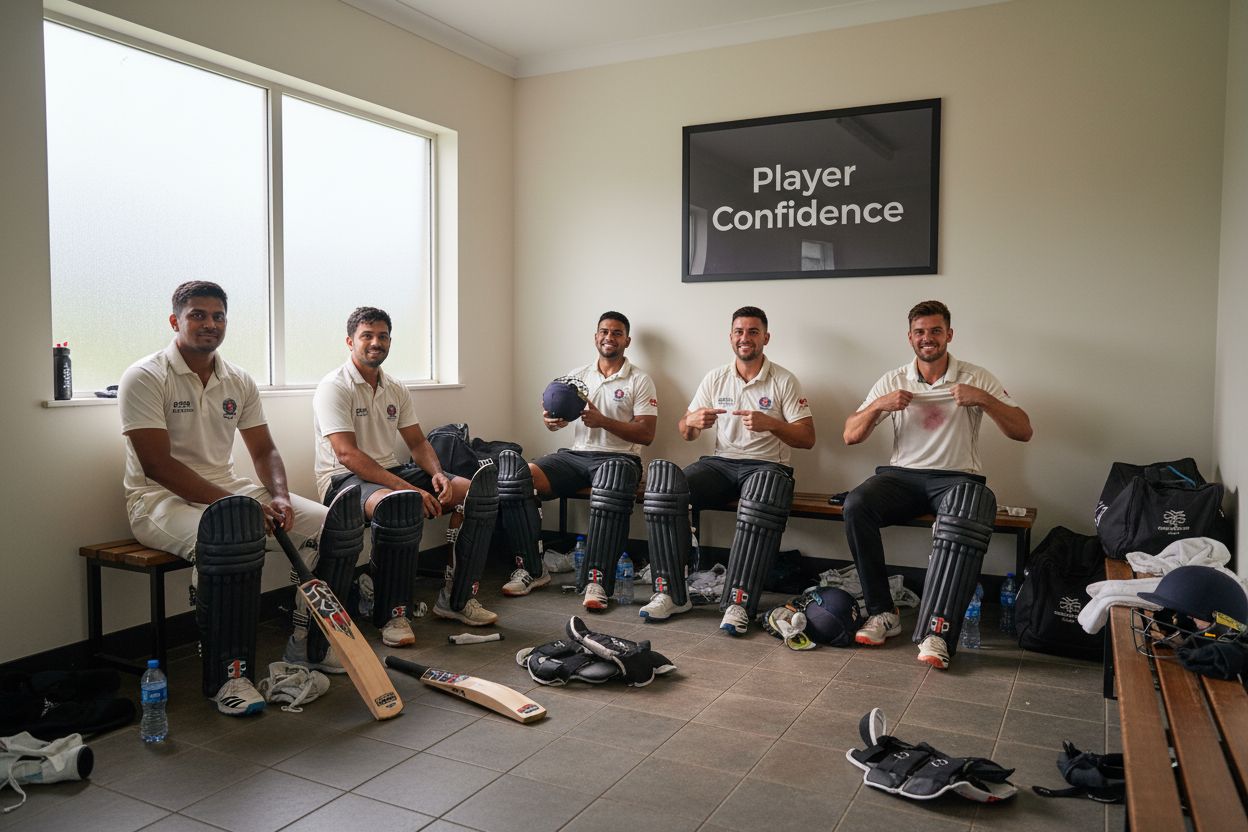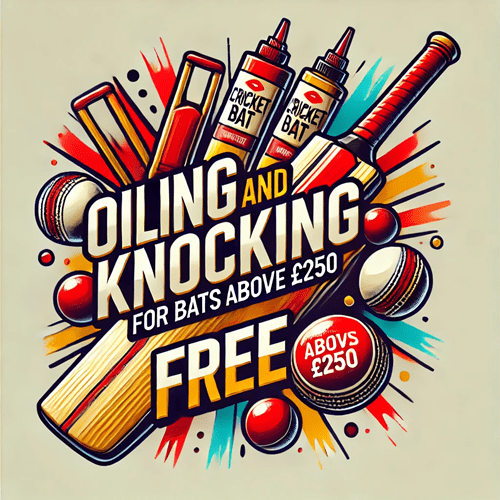Understanding Why Use Cricket Pads for Protection

Cricket pads have become as essential to the sport as the bat and ball. The reason might surprise you. A cricket ball can reach speeds over 90 miles per hour, turning a simple leg injury into a serious medical emergency in seconds. Most people think pads just add comfort, but modern cricket pads are packed with advanced engineering that completely changes how players stay safe and perform at their best.
Table of Contents
- What Are Cricket Pads And Their Purpose?
- The Importance Of Safety In Cricket
- How Cricket Pads Offer Protection
- Understanding The Design And Materials Of Cricket Pads
- Real-World Impact: Why Players Depend On Cricket Pads
Quick Summary
| Takeaway | Explanation |
|---|---|
| Cricket pads are essential for player safety. | They protect players from high-speed impacts with the cricket ball, reducing injury risks. |
| Modern pads use advanced materials. | High-density foam and reinforced plastics are crafted to absorb and distribute impact force effectively. |
| Pads prevent serious injuries during play. | They reduce the risk of fractures, bruising, and long-term leg damage caused by ball impacts. |
| Proper fit enhances performance and protection. | Adjustable straps ensure pads remain securely in place for optimal coverage and mobility. |
| Comprehensive safety strategies are crucial. | Beyond pads, a holistic approach includes training and other protective gear to ensure safety on the field. |
What Are Cricket Pads and Their Purpose?
Cricket pads represent a critical piece of protective equipment designed to shield players from potential injuries during batting and fielding. According to Britannica, these specialized protective guards have been a standard part of cricket attire for decades, serving a fundamental role in player safety.
Understanding Cricket Pad Anatomy
Cricket pads are protective leg coverings typically constructed from high-density foam, plastic, and sturdy fabric materials. They are specifically engineered to absorb and deflect the significant impact of a hard cricket ball traveling at high speeds. The standard design covers the front of a player’s lower leg, extending from the ankle to just below the knee, providing comprehensive protection for the most vulnerable areas.
To help readers understand the different components and their functions, the table below breaks down the key parts of a cricket pad and their specific protective purposes.
| Pad Component | Description | Purpose |
|---|---|---|
| Shin Guard | Front section covering the shin | Shields the lower leg from direct ball impacts |
| Knee Roll | Extra padding around the knee | Protects the knee joint from high-speed collisions |
| Straps | Adjustable fastenings | Securely holds the pad to the player’s leg |
| Rigid External Shell | Hard outer layer | Deflects and redistributes incoming forces |
| Compression Padding | Material that compresses on impact | Absorbs kinetic energy to reduce injury risk |
| Breathable Fabric | Moisture-wicking layer | Maintains comfort during extended play |
Key components of cricket pads include:
- Shin Guard: The primary protective section covering the front of the leg
- Knee Roll: Additional padding around the knee area for enhanced protection
- Straps: Adjustable fastenings that secure the pad to the player’s leg
Purpose and Performance Protection
The primary purpose of cricket pads goes far beyond simple cushioning. They are engineered to prevent serious injuries that could occur from direct ball impacts. A cricket ball can travel at speeds exceeding 90 miles per hour, making protection crucial for players at all skill levels. By absorbing and dispersing the ball’s kinetic energy, pads significantly reduce the risk of bone fractures, deep tissue bruising, and potential long-term leg damage.
Whether you are an amateur player or a professional cricketer, our comprehensive cricket gear buying guide can help you understand the nuanced selection of protective equipment that ensures your safety on the cricket field.
The Importance of Safety in Cricket
Safety stands as the paramount consideration in cricket, a sport where high-speed projectiles and physical dynamics create significant potential for injury. According to the International Cricket Council, implementing comprehensive safety protocols is crucial to protecting players across all levels of competition.
Understanding Injury Risks in Cricket
Cricket involves multiple scenarios where players face substantial physical risks. Batsmen confronting fast bowlers, fielders positioned close to the batting area, and wicketkeepers standing near high-velocity ball trajectories are particularly vulnerable. The cricket ball, typically weighing between 155.9 and 163 grams, can travel at speeds exceeding 90 miles per hour, transforming it into a potentially dangerous projectile capable of causing severe trauma.
Key injury risks include:
- Head and Facial Injuries: Direct ball impacts can cause concussions or facial fractures
- Limb Damage: High-speed balls can cause bone fractures and deep tissue bruising
- Soft Tissue Injuries: Sudden movements and impacts can lead to muscle strains and ligament damage
Comprehensive Safety Equipment Strategy
Effective injury prevention requires a holistic approach to protective gear. Beyond cricket pads, players must utilize a range of specialized equipment designed to minimize physical risk. Our comprehensive cricket equipment checklist provides detailed guidance on selecting and using protective gear that ensures player safety.
Modern cricket safety strategies emphasize not just physical protection, but also comprehensive training in proper technique, situational awareness, and risk management. Protective equipment acts as the critical last line of defense, absorbing and dispersing potentially dangerous impact forces that could otherwise result in serious injury.
This table summarizes the main injury risks in cricket and how comprehensive safety equipment—including pads—plays a critical role in protecting players during matches.
| Injury Risk | Potential Consequence | Protective Equipment Role |
|---|---|---|
| Head and Facial Injuries | Concussions, fractures | Helmets, face guards |
| Limb Damage | Bone fractures, deep tissue bruises | Pads (legs), gloves, arm guards |
| Soft Tissue Injuries | Muscle strains, ligament damage | Pads, proper footwear, overall gear |
| Direct Impact Trauma | Severe pain, long-term damage | Cricket pads, chest guards |
| Psychological Effects | Fear of injury, reduced performance | Confidence from trusted protective equipment |
How Cricket Pads Offer Protection
Research from Sports Medicine International reveals that cricket pads employ sophisticated protective mechanisms to mitigate potential injury risks during gameplay. These specialized protective garments function through a complex combination of materials and design principles aimed at dispersing and absorbing kinetic energy.
Material Science and Impact Absorption
Cricket pads utilize multilayered construction techniques that transform potential injury scenarios into manageable impacts. The primary protective layers typically consist of high-density foam, reinforced plastic shells, and shock-absorbing materials strategically positioned to distribute force across the pad’s surface. This engineering approach prevents concentrated impact points that could cause serious injury.

Key protective design elements include:
- Shock Dispersal Zones: Engineered areas designed to spread impact energy across a wider surface
- Compression Padding: Materials that compress and absorb kinetic energy upon ball contact
- Rigid External Shells: Hard outer layers that deflect and redirect incoming projectile forces
Biomechanical Protection Principles
Beyond material composition, cricket pads provide protection through precise anatomical coverage. They are meticulously designed to shield the most vulnerable leg regions vulnerable to cricket ball impacts. The padding extends from the ankle to just below the knee, creating a comprehensive protective barrier against potential trauma.
For players seeking additional safety insights, our detailed guide on cricket helmet types complements the understanding of comprehensive protective strategies in cricket. The integration of advanced materials and strategic design ensures that modern cricket pads represent a critical component in player safety, transforming potential injury risks into manageable sporting challenges.
Understanding the Design and Materials of Cricket Pads
According to advanced sports equipment research, cricket pad design represents a sophisticated intersection of materials engineering, biomechanical understanding, and player protection strategies. Modern cricket pads are not merely protective accessories but highly engineered performance equipment designed to provide maximum safety with minimal performance interference.
Material Composition and Technological Innovation
Contemporary cricket pads integrate multiple advanced materials to create a comprehensive protective system. The core design typically incorporates high-density foam, lightweight polymers, reinforced plastic shells, and specialized fabric technologies. These materials are carefully selected and combined to provide optimal impact absorption, weight distribution, and flexibility.
Key material characteristics include:
- High Density Foam: Provides primary shock absorption and energy dissipation
- Reinforced Plastic Shells: Creates rigid protective external layers
- Breathable Synthetic Fabrics: Ensures moisture management and comfort during extended play
Ergonomic Design Principles
Beyond material selection, cricket pad design focuses intensely on ergonomic considerations. The modern pad is engineered to contour precisely to the human leg, providing comprehensive protection without restricting movement. Strategic padding placement ensures that vulnerable areas like the shin, knee, and lower thigh receive maximum protection while maintaining the player’s range of motion.
For cricket enthusiasts seeking deeper insights into protective gear selection, our comprehensive cricket equipment checklist offers detailed guidance on choosing the most suitable protective equipment for different playing levels and styles.
Real-World Impact: Why Players Depend on Cricket Pads
Medical research from the British Journal of Sports Medicine demonstrates the critical role cricket pads play in preventing serious lower limb injuries during competitive play. These protective devices are not merely optional equipment but essential safeguards that professional and amateur players rely on to minimize potential career-threatening injuries.
Injury Prevention in Professional Scenarios
Professional cricketers consistently encounter high-velocity ball impacts that can cause significant physical trauma. Cricket pads serve as a crucial barrier between the player’s vulnerable leg anatomy and the potentially devastating force of a cricket ball traveling at extreme speeds. The strategic design of modern pads allows players to maintain confidence and aggressive gameplay without compromising personal safety.
Significant injury risks mitigated by cricket pads include:
- Direct Impact Trauma: Preventing bone fractures and deep tissue damage
- Soft Tissue Protection: Reducing muscle strain and ligament injuries
- Psychological Confidence: Enabling players to perform without fear of severe injury
Performance and Safety Correlation
Contrary to traditional perceptions, cricket pads do not merely protect players but actively contribute to performance optimization. By providing comprehensive leg coverage and impact absorption, these specialized protective garments allow athletes to focus entirely on their technical skills and strategic gameplay. The confidence derived from reliable protection translates directly into more aggressive and decisive on-field performance.

Our guide on sensor-equipped cricket bats further explores how technological innovations are transforming player safety and performance across cricket, complementing the protective advancements in equipment design.
Experience Real Protection and Confidence with CricketKingdom.co.uk
You understand how a fast cricket ball can create genuine risk for your legs. As highlighted in the article, injuries from powerful impacts are a constant threat for both amateurs and professionals. Feeling confident and safe while you play starts with reliable protection. If you have ever worried about serious trauma or felt limited on the pitch by subpar gear, it’s time to invest in real peace of mind. Explore the importance of advanced design, comfortable materials, and expert-crafted cricket pads that keep you focused on the game rather than the danger.

At CricketKingdom.co.uk, you will find a full range of high-quality cricket pads and protective gear, all chosen for maximum impact absorption and comfort. Shop today to take advantage of free shipping for qualifying orders and enjoy the security of equipment trusted by experienced players. Unsure where to start? Our cricket gear buying guide breaks down the best choices for every skill level. Discover the right pads now and protect your best game with professional-grade gear while supplies last.
Frequently Asked Questions
Why are cricket pads essential for player safety?
Cricket pads are essential for player safety because they protect the lower legs from high-speed ball impacts, which can cause serious injuries. Investing in quality pads can help prevent risks like bone fractures and deep tissue bruising during play.
How do cricket pads absorb impact from a cricket ball?
Cricket pads absorb impact through a combination of high-density foam and shock-absorbing materials that disperse the energy from a cricket ball striking the pad. To ensure maximum protection, choose pads designed with multilayered construction for effective impact absorption.
What features should I look for in cricket pads?
When selecting cricket pads, look for features such as high-density foam for shock absorption, knee rolls for added protection, and adjustable straps for a secure fit. Prioritize pads that provide comprehensive coverage from the ankle to just below the knee to safeguard vulnerable areas.
How do cricket pads enhance a player’s confidence during play?
Cricket pads enhance a player’s confidence by providing reliable protection against potential injuries, allowing them to focus on their game without fear of getting hurt. To boost your confidence, use pads that fit well and have proven protective capabilities.
Can I use cricket pads for other sports or activities?
While cricket pads are specifically designed for cricket, they can offer some protection for other sports with similar impact risks. However, the fit and design may not be suitable for different activities, so consider using sport-specific protective gear for optimal safety.
How often should I replace my cricket pads?
You should replace your cricket pads when they show signs of wear and tear, such as cracks or fraying material, which can diminish their protective capabilities. Regularly inspect your pads, and aim to replace them every one to two seasons, depending on usage.
Recommended
- Understanding Cricket Gear Buying Guide for Players – The Cricket Kingdom
- Understanding Types of Cricket Helmets for Safety – The Cricket Kingdom
- 9 Essential Items for Your Cricket Equipment Checklist – The Cricket Kingdom
- Essential Cricket Equipment in the UK: Must-Have Gear for Every Cricketer – The Cricket Kingdom


